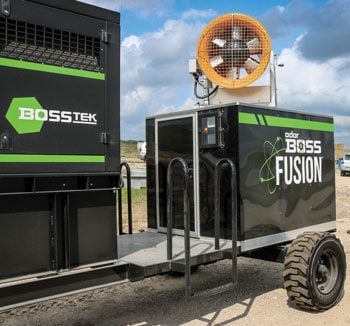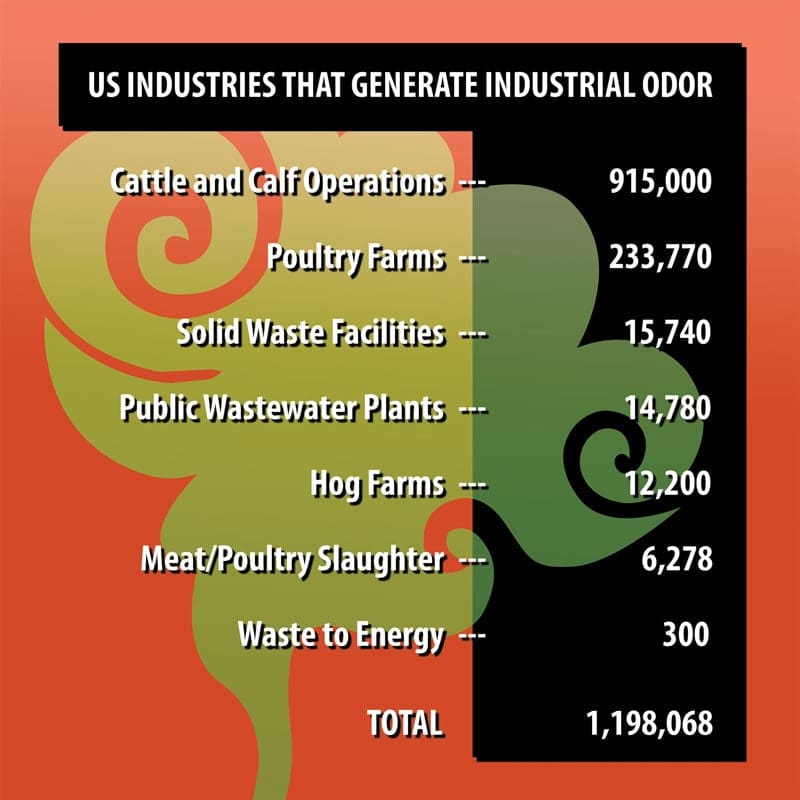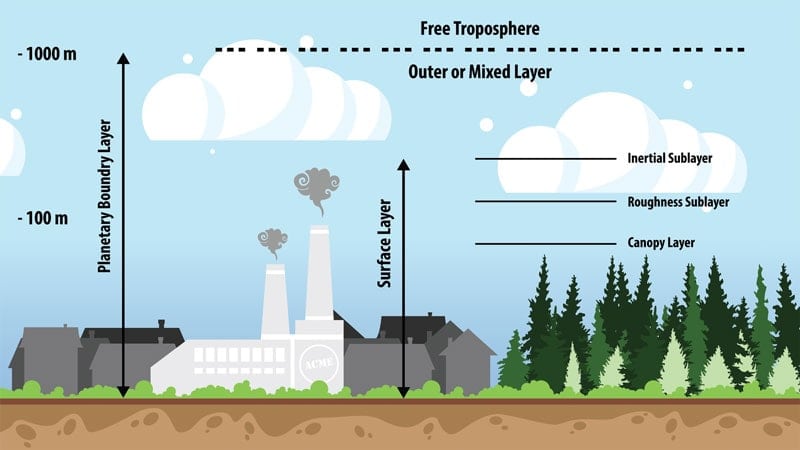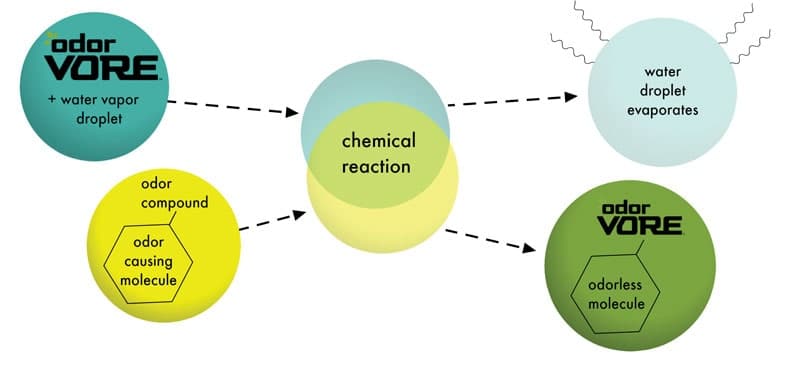When new communities encroach on previously secluded operations, odor emissions are typically not “grandfathered” into future permits. Choosing the correct technology that is easily maintained, adaptable to conditions, cost-effective over the long term and safe to operate is essential to any successful odor control plan.
By Jason Lesch and Mike Lewis
People at the local café, bar and community center all talk about it. They make jokes about it and the company emitting it. “It” is the odor. They know where it is coming from and when it will be most intense. They check the weather forecast, not just to find out if they need to wear shorts, but to determine whether they need to shut the windows and cancel outside activities due to the smell.

Images courtesy of BossTek.
Studies show that there are nearly 1.2 million odor-emitting facilities in the U.S., roughly one facility for every 300 Americans (see Figure 1, page 52).1 Complaints from just a fraction of the people affected will likely trigger a visit by a local DEQ (Department of Environmental Quality) inspector. It takes even fewer than that to create a class-action lawsuit, which could end up costing a company millions.
After spending a lot of time in the field speaking with a wide range of operators in odor-emitting industries, beyond the common emitters, we have seen an upswing in demolition and environmental remediation companies needing odor control. As general contractors reclaim urban and suburban land for new construction projects, they sometimes uncover latent odorous material. This subsumed waste is often a remnant from 19th and early 20th century unregulated industrial processing—such as asphalt manufacturing or chemical production—and the only thing hiding the smell is a thin layer of topsoil or concrete.
With the prevalence of increased suburban encroachment on once-rural operations, it is incumbent on operators to limit or stop community exposure. However, many essential industries emit odors—from food and chemical production to waste processing—leaving these facilities open to expensive litigation and regulatory fines. To mitigate offsite odor episodes and to avoid the ensuing consequences, operators are turning to modern odor control technology such as safe, biodegradable chemical deodorizers delivered by innovative equipment at the source of the emission.
Regulations and Hotlines
Budgets and inspector time constraints fluctuate based on the fiscal priorities of local and state elected officials, so rather than periodically scheduled inspections, regulators often depend on complaints to prompt a site visit. Testing levels are not based on a uniform standard and can seem rather arbitrary. In their reports, inspectors may describe the intensity, reach and effectiveness of control methods and make a judgment call as to subsequent action. The result can be a Notice of
Violation (NOV), possible fines, enforcement orders, disrupted operations or even facility closure.
NOVs and inspection reports can be accessed by the public and are often monitored by class action law firms for possible litigation. To avoid triggering inspections, some facilities establish and publicize their hotlines to field complaints and address them on an individual basis. By doing this, operators can better pinpoint local areas and times when emissions are most problematic.
The data can also inform the implementation of the proper type of odor control equipment. For example, complaints from nearby communities may be addressed with perimeter sprays and natural barriers, whereas complaints from as far as a mile away may indicate that the odor is rising to upper air currents, requiring treatment directly at the source or working face.
Litigation
There are three common factors in most civil lawsuits regarding air quality:
1. Monetary losses—These can include reduced property value, disrupted resale of property, smell disrupting normal business operations or affecting crop/product quality.
2. Quality of life (pain/suffering)—Some people are sensitive to smell and are unable to function outside during periods of intense odor. There are instances when little league games, outdoor markets and other community activities have been disrupted or canceled due to odor.
3. Negligence or malfeasance—The operator knowingly violates a duty to control emissions as stated in its operating permit. The company ignores a NOV or takes inadequate action.
An example of this was the civil case, Beck v. Stony Hollow Landfill, filed in Ohio in 2012 and settled in 2018.2 The class-action lawsuit spearheaded by Carly Beck and 160 other households within 2.5 miles of the facility stems from complaints beginning in 2002 followed by violations issued by regulators. It cites all three factors stated above in requesting $5 million in damages. The resulting settlement of $4.1 million includes a requirement that the business spend $1.2 million in remediation efforts and odor control technology. It also puts heavy restrictions on further operation or expansion, potentially affecting profitability.
Environmental Causes and Dispersal of Odor
Odors typically begin with the structure of molecules containing some combination of five elements: carbon, nitrogen, oxygen, sulfur and/or hydrogen. Bacteria grow and multiply by digesting these elements. Odor emissions occur when organic solids volatize faster than the bacteria can process it, creating a volatile organic compound (VOC). The emissions can be spread and increased by certain environmental and industrial factors. Common factors that cause emissions at the source are:
Disruption—Large machinery moving material at the working face or during the loading/offloading process increases emissions.
Heat—Higher temperatures promote the decay and volatilization process of VOCs, while exposing more surface area to the air.
Exposure to Air—Aeration can increase emissions by releasing trapped odor molecules and increasing volatility.
Types of Site Line Containment During Operation
Controlling odor emissions during operation is dependent on several factors, including wind, weather, type of emission, source and logistics (material handling and transport). Some operations—such as chemical manufacturing, cannabis production, food production or waste processing facilities—may have enclosed systems with internal odor control (bioscrubbers, biotrickling, activated sludge diffusion, etc.). Unfortunately, most large outdoor emitters such as landfills, wastewater treatment, composting and dairy operations do not have these options. This leaves them with two choices: airborne or topical control.

Natural barriers, including impounds (natural crevasses, old quarries, etc.) or densely planted tree lines, can help control the spread of the odor by restricting airflow. Forests, foliage and soil can capture and absorb some of the molecules. However, airborne odor can rise above the atmospheric canopy layer to be carried long distances.
Typically installed around the site-line, perimeter misting systems are essentially long hoses with tiny holes that emit a water-based masking agent or deodorizer. Aside from only treating odor once it has already traveled to the site line, operators have reported that the systems struggle to reach the canopy airflow layer immediately above the ground (see Figure 2). Odor quickly rises into airflow layers above, which extends the travel distance considerably.

The limited reach of perimeter systems reduces their coverage range and effectiveness. Moreover, masking agents do not eliminate the smell. They simply mix with the odor-causing molecules in an attempt to disguise them, in some cases compounding the issue.
Some facilities use water trucks equipped with spray bars or misting nozzles that emit a water-based masking agent or chemical deodorizer. The volume of water needed to operate these vehicles can require several trips to a refilling site within a single shift. Also, they are restricted to easily traveled and level terrain, which may not be conducive to operations that use quarries or other natural impounds.
Treating the Problem at the Source
Perhaps the most common method of containing odor at the source is by using fabric covers, soil and/or chemical foam over exposed material. Odorous gasses can build up under the cover layer, with subsequent disruption or erosion releasing the accumulation. In a working area, this concentration can emit more intense and wider-reaching odors (such as methane) that could potentially be ignited by machinery. Applying chemical foam can also be a safety issue, as it generally requires one or two people working alongside active heavy machinery to control the hose, and it can introduce the possibility of slip, trip or fall injuries.
Limiting certain activities such as aeration, offloading and disruption to early morning or after sunset can mitigate some of the odor. Some operators are also altering activities on weekends and holidays to reduce emissions when the community is most likely to be active outside.
A number of operations are experiencing success with innovative “cannons” to distribute biodegradable deodorizing chemical treatments, which have proven to be a viable control method for both airborne and topical odor treatments. The difference with this approach is in the chemical used and the delivery system.
A cannon with a high-powered fan and engineered nozzle system widely disperses a nearly invisible and scentless chemical into the air or directly onto the surface, right at the point of emission. The microscopic chemical droplets travel on the same ambient air currents as the smell, interacting with the odor on a molecular level, which results in an inert chemical compound (see Figure 3).

Airborne Versus Topical Treatments
Once an odor has become airborne, it is subject to air currents and becomes more difficult to control. By the time airborne odor has reached the perimeter fencing system, it has likely had the opportunity to rise into upper atmospheric airflow layers. Topical coverage with soil and foam only postpones emissions and may actually intensify the odor once released. Without proper source mitigation, airborne emissions are inevitable. We have found that attacking odor at the source, the moment it becomes airborne—or even before—is the most effective way to stop emissions without disrupting operations. Our customer experiences have shown that deodorizing chemicals, delivered over a wide area by a powerful fan-driven cannon, are effective for both topical and airborne treatment. It has been highly successful in stopping odors before they reach the site line.
Obstacles to Odor Control
Depending on the conditions, operators face a wide range of obstacles that limit odor control methods and options including weather, accessibility, mobility, cost, safety and effectiveness.
Reacting to changes in wind direction requires mobile odor control technology that can be easily directed specifically at the desired target, particularly when odors are generated at more than one location. In operations where the odor source consistently originates from the same place, tower-mounted designs deliver extended range and coverage, with the ease of operation via remote control. Accessibility to water and power can also hamper odor control efforts, while uneven ground or rough terrain can limit the use of trucks. Natural impounds can pose accessibility issues such as steep, narrow ramps, sheer drops and unstable edges.3
Self-contained designs are available that provide the necessary power and chemical delivery systems for a continuous run time of up to 10 straight days without refueling. Mounted on a rugged agricultural trailer with foam-filled tires, the entire system is engineered with industrial-strength components to withstand difficult operating environments. Units can also be ordered on a street-legal roadworthy trailer for customers who may need to transport the equipment between facilities, and some designs feature a heated enclosure and nozzles with heat tracing to allow operation in virtually any weather.
The true lifecycle cost lies not only in the equipment itself, but also in ongoing maintenance, labor and chemical pricing. The greatest efficiency comes from designs that can run without human attention for long periods of time. Some models can deliver as much as two months of operation from a standard 275-gallon tote of odor control chemicals. The most innovative designs are compatible with remote control and automated operation via programmable logic control (PLC).
An effective odor control plan will have the ability to help limit offsite odor episodes, reduce complaints, avoid DEQ violations and minimize potential liability. This efficacy is a function of both the equipment and the chemicals being used.
Environmentally-Friendly Suppression
Odor control cannons have proven successful across a wide range of industries over the last several years, with ongoing advancements in developing non-toxic, environmentally sustainable and biodegradable chemicals. New designs eliminate water dilution by using a patent-pending waterless delivery system that has proven to be a highly effective approach to neutralizing odor-causing molecules.
Some deodorizing chemicals take advantage of environmentally-responsible formulations that biodegrade in as little as three days. Current products are effective on a wide range of odor sources, including VOCs, sulfides, mercaptans, amines and ammonia. They can be specified as unscented or with a variety of natural tracer scents, including cinnamon and fresh-cut grass. Digital dosing capabilities can adjust chemical output, run time intervals and duty cycles to suit specific application needs.
An Effective Plan
An essential component of waste management and sustainable production is odor mitigation. When new communities encroach on previously secluded operations, odor emissions are typically not “grandfathered” into future permits. Choosing the correct technology that is easily maintained, adaptable to conditions, cost-effective over the long term and safe to operate is essential to any successful odor control plan.
Naturally, operators want to try a variety of tactics to find what works best, because an effective odor control plan often includes multiple methods for redundancy. But the discovery process and field testing can be expensive. With such a large capital expenditure, finding methods that can be rented or field tested without the need to purchase is often the most economical route. | WA
Case Study: A Demolition Site
While conducting testing for a demolition project in the Eastern U.S., an environmental consulting firm found coal tar waste had leached into the ground on the 11-acre site of a decommissioned LP gas plant that had operated for nearly 100 years. Coal tar can contain up to 50 percent naphthalene, a VOC consisting of benzene, which emits an intense odor. The estimated 85,000 tons (77,110 metric tons) of excavated soil was piled into storage mounds approximately 30 to 40 feet (9 to 12 meters) high.
As excavators and front loaders disrupted material in the ground and stored in piles, the odor was released and immediately carried on air currents. Higher temperatures increased the intensity of the smell. Complaints about odor emissions caused regulators and local legislators to pressure managers into halting operations and covering all exposed material with chemical foam and/or plastic sheeting until the operators were able to find a viable solution. They decided on an OdorBoss® industrial cannon design with an airborne deodorizer from BossTek (Peoria, IL).
The unit was fed with hoses running to tanker trucks and attached to the local power grid. The equipment operated during the day, and the piles were sealed with plastic at night. Positioning the cannon upwind, while using oscillation and the vertical adjustment, the chemical was successfully distributed in the path of the fugitive odor and toward emissions from the top of the storage piles, treating the odor before it could reach the site line. After implementing the solution, the community complaints stopped, and the site did not experience any further downtime due to odor.
Jason Lesch is Lead Engineer, BossTek (Peoria, IL), a global leader in dust and odor control solutions for the processing, storage and handling of bulk materials. Operations large and small in a variety of industries have discovered the technology to be a versatile solution throughout all project phases. The company offers machines for purchase or rent and has worked closely with operators to create customized solutions when needed.
Mike Lewis is the Sales Manager at BossTek, with the primary responsibility of understanding commercial and industrial dust and odor suppression needs, identifying solutions and providing expert service to customers all over the world. He has traveled extensively throughout North America, investigating site-specific dust/odor management issues and helping customers maintain efficient, environmentally-responsible operations that comply with local and federal regulations.
For more information, visit www.bosstek.com.
References
Staff, “Industrial Odor Control is Big Business”, ACCESSWIRE / January 9, 2018. https://finance.yahoo.com/news/industrial-odor-control-big-business-133000409.html
“Beck v. Stony Hollow Landfill, Inc.” (3:16-cv-00455), Line 38. District Court, S.D. Ohio. Nov. 2018. www.courtlistener.com/docket/6100271/beck-v-stony-hollow-landfill-inc/
El-Fadel, Mutasem; Sadek, Salah; Walid, Chahine. “Environmental Management of Quarries as Waste Disposal Facilities”. Environmental Management 27(4):515-31 · May 2001. www.researchgate.net/publication/12045403_Environmental_Management_of_Quarries_as_Waste_Disposal_Facilities
You may also like:
Odor Control by Atomized Mist Aids Sugar Beet ProcessingClearing the Air: 3 Best Practices for Odor Control at MSW and Composting Facilities
